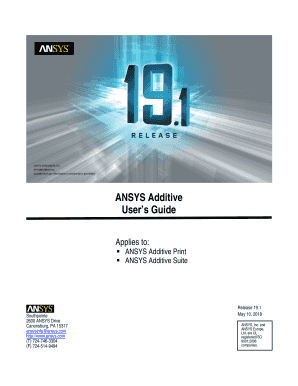
ANSYS Additive Desktop User's Guide Form


What is the ANSYS Additive Desktop User's Guide
The ANSYS Additive Desktop User's Guide serves as a comprehensive resource for users engaging with the ANSYS Additive software. This guide provides detailed insights into the functionalities, features, and best practices associated with the software. It is designed to assist both new and experienced users in navigating the complexities of additive manufacturing simulations and analyses. The guide covers essential topics, including installation procedures, user interface navigation, and troubleshooting tips, ensuring users can effectively utilize the software to achieve optimal results in their projects.
How to use the ANSYS Additive Desktop User's Guide
Utilizing the ANSYS Additive Desktop User's Guide involves several key steps to maximize its effectiveness. Users should start by familiarizing themselves with the table of contents, which outlines the various sections and topics covered. Each section is structured to provide clear instructions and practical examples. As users progress through the guide, they should take note of the highlighted tips and common pitfalls to avoid. Additionally, the guide includes visual aids and diagrams that enhance understanding, making it easier to apply the information to real-world scenarios.
Steps to complete the ANSYS Additive Desktop User's Guide
Completing the tasks outlined in the ANSYS Additive Desktop User's Guide involves a systematic approach. First, users should ensure that they have the latest version of the software installed. Next, they should follow the step-by-step instructions provided in the guide for specific tasks, such as setting up a new project or running a simulation. It is important to refer to the troubleshooting section if any issues arise during the process. Finally, users are encouraged to review the results and compare them with the expected outcomes, allowing for adjustments and improvements in future projects.
Key elements of the ANSYS Additive Desktop User's Guide
The ANSYS Additive Desktop User's Guide includes several key elements that enhance its usability. These elements consist of clear headings and subheadings that allow for easy navigation, as well as a glossary of terms that defines technical jargon. Additionally, the guide features screenshots and illustrations that provide visual context for the instructions. Each chapter concludes with a summary of key points and a list of frequently asked questions, which serve as a quick reference for users seeking clarification on specific topics.
Legal use of the ANSYS Additive Desktop User's Guide
Understanding the legal use of the ANSYS Additive Desktop User's Guide is crucial for compliance and proper utilization. The guide is intended for personal and professional use, adhering to the licensing agreements set forth by ANSYS. Users must ensure that they do not distribute or reproduce the guide without proper authorization. Additionally, any modifications to the software or its documentation should be approached with caution, as they may violate the terms of service. By following these guidelines, users can confidently leverage the guide while remaining compliant with legal standards.
Examples of using the ANSYS Additive Desktop User's Guide
Examples provided within the ANSYS Additive Desktop User's Guide illustrate practical applications of the software in various scenarios. For instance, a user may follow a detailed example of creating a 3D model for a specific additive manufacturing process, such as selective laser sintering. The guide outlines each step, from initial design to final simulation results, showcasing how to interpret data and make informed decisions based on the outcomes. These examples serve as valuable learning tools, helping users to apply theoretical knowledge in practical settings.
Quick guide on how to complete ansys additive desktop users guide
Complete [SKS] seamlessly on any gadget
Digital document management has become increasingly popular among businesses and individuals. It offers an ideal eco-friendly substitute for traditional printed and signed documents, as you can obtain the necessary template and securely store it online. airSlate SignNow provides you with all the tools required to create, alter, and electronically sign your documents quickly without delays. Manage [SKS] on any gadget with airSlate SignNow Android or iOS applications and enhance any document-related process today.
The easiest way to alter and electronically sign [SKS] effortlessly
- Locate [SKS] and click Get Form to begin.
- Utilize the tools provided to fill out your document.
- Emphasize important sections of your documents or obscure sensitive information using tools that airSlate SignNow provides specifically for that purpose.
- Create your signature with the Sign tool, which takes mere seconds and holds the same legal authority as a conventional wet ink signature.
- Review the information and click the Done button to save your modifications.
- Select how you wish to send your form, via email, SMS, or invitation link, or download it to your computer.
Say goodbye to lost or misplaced documents, tedious form searches, or mistakes that necessitate printing new document copies. airSlate SignNow meets your document management needs in just a few clicks from your preferred device. Edit and electronically sign [SKS] and ensure effective communication at any point of your form preparation process with airSlate SignNow.
Create this form in 5 minutes or less
Related searches to ANSYS Additive Desktop User's Guide
Create this form in 5 minutes!
How to create an eSignature for the ansys additive desktop users guide
How to create an electronic signature for a PDF online
How to create an electronic signature for a PDF in Google Chrome
How to create an e-signature for signing PDFs in Gmail
How to create an e-signature right from your smartphone
How to create an e-signature for a PDF on iOS
How to create an e-signature for a PDF on Android
People also ask
-
What is the ANSYS Additive Desktop User's Guide?
The ANSYS Additive Desktop User's Guide is a comprehensive resource designed to help users understand the features and functionalities of the ANSYS Additive Desktop software. This guide provides step-by-step instructions, best practices, and troubleshooting tips to enhance your experience and productivity while using the software.
-
How can I access the ANSYS Additive Desktop User's Guide?
You can access the ANSYS Additive Desktop User's Guide through the official ANSYS website, where it is available for download in PDF format. Additionally, the guide may also be integrated within the software, providing context-sensitive help directly within the application.
-
Is the ANSYS Additive Desktop User's Guide suitable for beginners?
Yes, the ANSYS Additive Desktop User's Guide is structured to cater to users of all skill levels, including beginners. The guide starts with basic concepts and gradually progresses to advanced topics, ensuring that new users can familiarize themselves with the software effectively.
-
What topics are covered in the ANSYS Additive Desktop User's Guide?
The ANSYS Additive Desktop User's Guide covers a wide range of topics including software installation, user interface navigation, feature descriptions, application workflows, and troubleshooting procedures. Each section is designed to help users maximize their use of the software and achieve optimal results.
-
Are there any updates to the ANSYS Additive Desktop User's Guide?
Yes, the ANSYS Additive Desktop User's Guide is regularly updated to reflect changes and enhancements in the software. Users are encouraged to download the latest version of the guide to ensure they have the most current information and instructions.
-
Can I find tutorials in the ANSYS Additive Desktop User's Guide?
Absolutely! The ANSYS Additive Desktop User's Guide includes various tutorials that illustrate key workflows and features within the software. These tutorials provide practical examples and are designed to help users apply what they have learned in real-world scenarios.
-
Does the ANSYS Additive Desktop User's Guide provide information on software integrations?
Yes, the ANSYS Additive Desktop User's Guide includes detailed information on how the software integrates with other tools and platforms. It explains the integration process and the benefits of linking ANSYS Additive Desktop with additional resources for streamlined workflows.
Get more for ANSYS Additive Desktop User's Guide
- Lease amendment amendment to lease form with sample
- Control number il p081 pkg form
- Starting a business in illinoischecklist and formsmycompanyworks
- Creditor list united states bankruptcy court southern district of form
- Self help forms housing evictions colorado judicial branch
- Name change packet indiana legal services form
- Control number in p024 pkg form
- Control number ak p023 pkg form
Find out other ANSYS Additive Desktop User's Guide
- Sign Ohio Land lease agreement Simple
- Sign Oklahoma Land lease agreement Computer
- Sign Oklahoma Land lease agreement Mobile
- Sign Oklahoma Land lease agreement Now
- Sign Ohio Land lease agreement Easy
- Sign Oklahoma Land lease agreement Later
- How To Sign Oklahoma Land lease agreement
- Sign Oklahoma Land lease agreement Myself
- Sign Ohio Land lease agreement Safe
- How Do I Sign Oklahoma Land lease agreement
- Sign Oklahoma Land lease agreement Free
- Sign Oklahoma Land lease agreement Secure
- Sign Oklahoma Land lease agreement Fast
- Sign Oklahoma Land lease agreement Simple
- Help Me With Sign Oklahoma Land lease agreement
- Sign Oklahoma Land lease agreement Easy
- Sign Oklahoma Land lease agreement Safe
- How To Sign Ohio Land lease agreement
- How Can I Sign Oklahoma Land lease agreement
- How To Sign Virginia House rental agreement